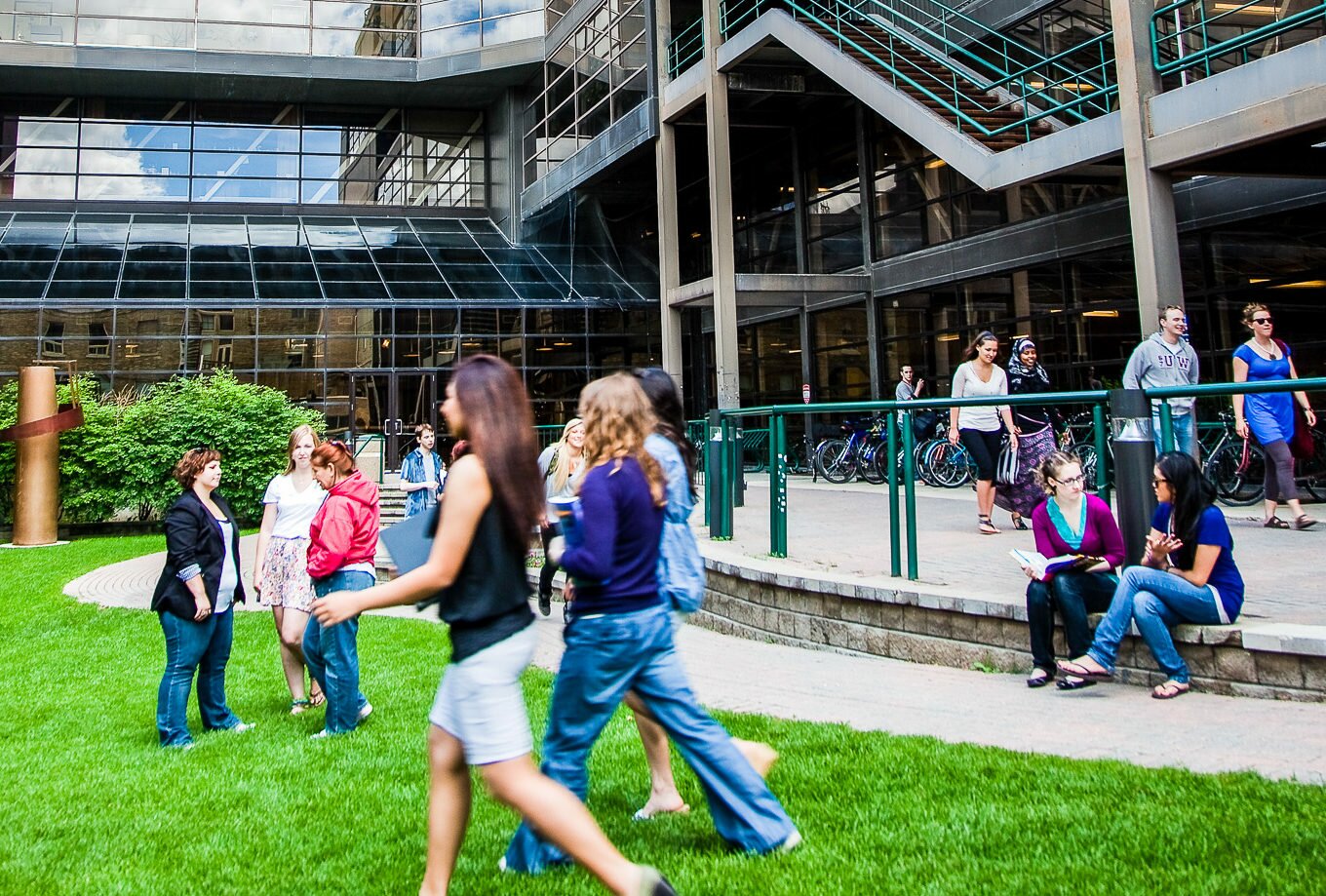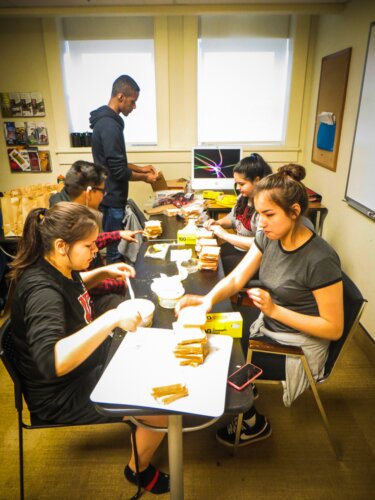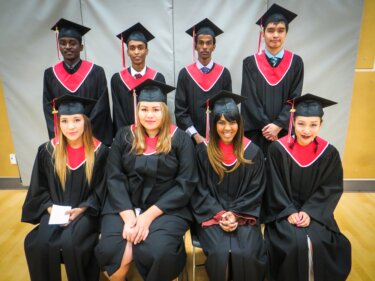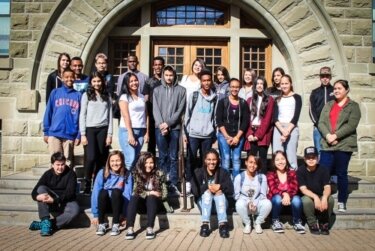Youth programs lower barriers to university
Youth engagement initiatives are proving to increase university enrollment, but meaningful reconciliation may entail redefining metrics of success.

In early May, eight students graduated from the Model School, a high school program at the University of Winnipeg (U of W) Collegiate. The Model School, which only enrolls 50 students per year, aims to eliminate some of the barriers to postsecondary education faced by inner-city and Indigenous youth.

Since its launch in 2008, 75 per cent of Model School graduates have enrolled in postsecondary education, mostly at U of W.
“It’s supportive and it’s welcoming, and if you start off in Grade 9, it gets to the point where you’re a totally different person,” says Grade 11 student Iroc Levasseur. “The Model School helped me go the right direction and pushed me into becoming a leader.”
The Model School is among a number of programs in Canada providing support for Indigenous youth in academic environments. There is cause to celebrate projects that do this work, says Aimée Craft, Director of Research at the National Centre for Truth and Reconciliation (NCTR). But measuring Indigenous success rates by postsecondary admission or retention rates alone is problematic, she says. These measurements may not align with Indigenous value systems and could actually “perpetuate colonialism,” she argues.
The Truth and Reconciliation Commission (TRC) released 94 calls to action in June 2015, some of which highlighted the need to bring more Indigenous people into postsecondary education. The TRC’s work is the most recent appeal for increased action in support of the rights of Indigenous Canadians to postsecondary education — rights long ago carved out by the 1982 Canadian Constitution.
While Canadian universities themselves are implementing policies and programs in response to the TRC’s calls to action, it’s still too early to say which will bring transformative change.
Raising high school graduation rates, experts claim, is the single most effective way to bring more Indigenous people into universities. This requires more funding for Indigenous youth in schools, they say, along with academic and cultural initiatives that work with children as young as four years old.
How long are Indigenous people staying in school?
Indigenous people leave the education system earlier than non-Indigenous people. This is most prevalent in western provinces and territories.
Not all Indigenous people view the education system as a means of achieving their goals ― many, in fact, associate it with colonization and Canada’s history of purposeful efforts to integrate Indigenous people into Canadian culture that gave rise to residential schools.
Craft opposes the use of metrics like “economic benefit” or “rate of educational attainment” to measure Indigenous success. “We need to adjust the metrics. ‘Alleviation of poverty’ might be a better way of putting it than ‘economic impact’. Because if the idea is to economically benefit Canada, how does that translate to the circumstances of Indigenous people?” asks Craft.
“If we’re always weighting the broader societal interest as being the optimal measure, then we’re missing out on something.”
The 2011 National Household Survey reported that 12 per cent of Canada’s non-Indigenous population lacked any certificate, diploma or degree, in comparison to 29 per cent of the Indigenous population. Further, it showed the rate of employment within the non-Indigenous population was 13 per cent higher than that of the Indigenous population.
According to the survey, the largest disparity exists not in trades or college programs, but at the university level — a gap ultimately linked to lower rates of employment. According to estimates by Employment and Social Development Canada, by the end of the next decade, more than 70 per cent of new jobs will require postsecondary education.
A study by Matthew Calver for the Centre for the Study of Living Standards showed that “closing the education gap” that exists between Indigenous and non-Indigenous people between 2011 and 2031 could bring as much as $261 billion to the Canadian economy.
Students and staff at the Model School credit its success to the financial assistance and one-on-one mentorship, tutoring and support that attendees receive from Grade 9 onwards.
Jerry White, professor of sociology at Western University in Ontario, touts U of W’s program as a national leader. It’s an example, White suggests, of the finding that increasing the number of Indigenous students graduating from high school will positively impact how many go on to enroll in postsecondary.

“What our studies show is that if we can increase Grade 12 graduation rates, we will increase the number of students coming to university who are successful,” says White. “Scientifically, it’s quite clear.”
The 2016 federal budget has promised a $4.6 billion investment in Indigenous education over the next five years, butWhite says funding for the particular needs of First Nations youth in schools is still inadequate.In 2010 The Assembly of First Nations said “chronic underfunding” of First Nations (on-reserve) schools by Indigenous and Northern Affairs Canada (INAC) over the past 30 years had resulted in a “$747 million funding shortfall.” There had been a cumulative funding shortfall of more than $3 billion since 1996, they noted.
In past years, some have argued that students on reserves receive anywhere from 20 to 50 per cent less than the average Canadian student.
“The education funds that are available are not enough to be able to keep teachers in schools, to build libraries and have sports, to be able to cope with some of the special issues that go on — in terms of the health and well-being of students,” says White.
Socioeconomic barriers
The Model School receives 50 per cent as much funding as its public high school counterparts receive, and fills in the funding gap through private donors. Because it only enrolls 50 students at a time, program director Ian Elliott concedes the school, on its own, can’t support all the inner-city youth in Winnipeg who could benefit from the program. This was a point Lloyd Axworthy, past U of W president, sought to indicate in its name. “The name ‘the Model School’ was just to serve the purpose of being a model for what could be done,” says Elliott.
“Telling [kids], ‘This is a place you can come to when you’re finished your Grade 12,’... opens up the university as a possibility, as something real that they could do.”
He describes some of the challenges faced by students attending the school: one current attendee has experienced the deaths of three close family members in the past year. Others have family members who are incarcerated. Most students, he says, experience poverty or financial troubles at home.
The program attempts to minimize those socioeconomic barriers by providing students with food, transportation, and more staff support than they would likely receive in the public school system. They take part in smudging ceremonies (an Indigenous tradition of burning sweetgrass, sage or cedar) and hear lectures from prominent Indigenous figures. Workshops advise students on resumé-writing and certify them in babysitting and CPR. Fees for all of these activities are covered, says Jarita Greyeyes, the school’s acting associate vice-president of Indigenous affairs.
‘University-bound identities’
Model School student Iroc Levasseur can’t decide whether she wants to practice law or coordinate youth programs on Indigenous reserves when she gets older.
But the 16-year-old from Ebb and Flow First Nation in Manitoba says the school has given her the confidence — and the resources — to be able to choose what she does with her future. Levasseur and the other students are rewarded for good grades and extracurricular involvement with up to $4,000 in tuition credits that can be used at U of W when they graduate.
“It’s prepared me [for university], and I don’t have to worry about it financially or anything,” says Levasseur.

“When I first came [to the Model School], I was really intimidated and really scared, because I didn’t know what to expect. I was shy and kind of quiet. Now I’m more comfortable — I speak up, and I’m not intimidated,” she says, pointing to supports like early morning homework help and extra courses.
The Model School forms one part of U of W’s Community Learning programs, an initiative Greyeyes describes as driven to “cultivate university-bound identities.” It intercepts inner-city kids as early as preschool age for reading circles and math and science camps. As they grow up, they’re invited to participate in healthy relationship groups, language lessons and powwow clubs.
Greyeyes says Community Learning was developed to counteract a feeling that the university campus “wasn’t a place where our neighbours really belonged.”
“I think there was a sense from the community that there wasn’t a place that was theirs,” she says.
Sociology professor Jerry White says universities across the country, including Western University, are following U of W’s lead by inviting Indigenous students of all ages to spend time on their campuses through community outreach, camps, tutoring and field trips.
“Coming physically to these places and telling [kids], ‘This is a place you can come to when you’re finished your Grade 12,’ opens up a whole new line of discussion in their brains. It opens up the university as a possibility, as something real that they could do,” says White.
“We would like communities to feel that this is a safer space.”
Trauma-informed learning
Christopher Blodgett, an expert in childhood trauma at the University of Washington in the U.S., says one in five American children have experienced two or more adverse childhood experiences (ACEs). ACEs are potential traumas, including poverty; physical, emotional or sexual abuse; and parental divorce or incarceration.
Blodgett, Director of CLEAR (Collaborative Learning for Educational Achievement and Resilience) Trauma Center at the University of Washington, says exposure to trauma is directly linked to a student’s ability to succeed in school. But his research shows that by shifting to a trauma-informed perspective, schools and their staff can see traumatized children thriving.
Reformed school policies, Blodgett says, will ultimately help staff support both Indigenous and non-Indigenous children who have experienced trauma. Policy changes can include more training for teachers around childhood development and its link to trauma, as well as shifting from systems of punishment and suspension at school toward systems that value accountability and trust.
“We’re finding there’s a lot of professional development required to really equip educators to deal with these types of issues and [create] systems to be supportive of them doing that,” he says.
When asked about the prevalence of intergenerational trauma at the Model School,The TRC acknowledges the role of trauma in many Indigenous communities: “While some former students had positive experiences at residential schools, many suffered emotional, physical and sexual abuse, and others died while attending these schools. The unresolved trauma suffered by former students has been passed on from generation to generation.” Elliott references a letter he received in an application from a prospective student in Grade 8.
“A place of reconciliation in academia is about developing relationships of honest discussion about whether or not universities can meet the needs and aspirations of Indigenous people in all ways.”
“One of the comments in the letter was, ‘To my family, today’s schools are no different than residential schools.’ That was something that struck home with us when we read it amongst the staff,” says Elliott.
“But that’s something that speaks to it right there. [Intergenerational trauma] is very powerful and it definitely has an effect on young people, I think. Even 13-year-olds.”
‘Honest discussion’
With Indigenous youth starting to gain improved access to postsecondary education, universities themselves are being called upon to evaluate how they meet the needs of these students.
While stating that Indigenous values and university systems are not necessarily in direct opposition, the NCTR’s Aimée Craft says that simply moulding Indigenous students to fit into traditional academic structures is certainly problematic. It’s a task, she says, directly at odds with universities’ ongoing responsibility to facilitate reconciliation.
“A place of reconciliation in academia is about developing relationships of honest discussion about whether or not universities can meet the needs and aspirations of Indigenous people in all ways,” says Craft.
“It’s not a question of investing a bunch of resources now and then thinking that we are reconciled,” she adds.
Pointing out that transformation must happen below the surface at universities, Craft calls for more balanced relationships between Indigenous systems of knowledge and traditional university coursework.
As for how the universities are doing with this task, Craft says, “It’s to be determined. I think we should be celebrating establishing foundations and opportunities to open up the dialogue, but certainly not celebrating the ultimate achievement of reconciliation.
“I don’t think anyone should be celebrating success yet.”
Have you participated in a high school program like the Model School? If so, what did you gain from it and how might these programs be improved? Email us at:
In our next investigation we will explore the university experiences of Indigenous students. Tell us how your campus is facilitating reconciliation, or if you’ve noticed any recent changes to the university environment or the courses being taught. If not, what would you like to see change? Email us at:
